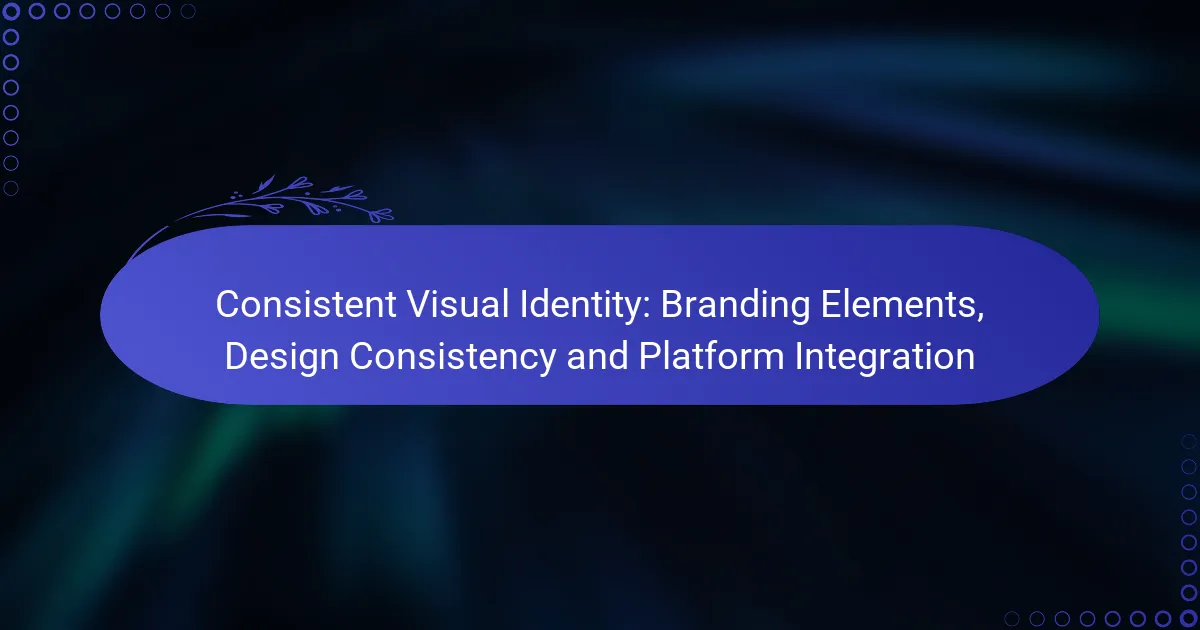Establishing a consistent visual identity is crucial for effective branding, as it involves the strategic use of branding elements and design styles across various platforms. By maintaining uniformity in logos, color schemes, typography, and imagery, brands can create a cohesive presence that enhances recognition and fosters consumer trust. This design consistency not only makes a brand easily identifiable but also strengthens its overall impact in the marketplace.

How to Achieve Consistent Visual Identity Across Platforms?
Achieving a consistent visual identity across platforms involves using the same branding elements, design styles, and integration techniques. This ensures that your brand is easily recognizable and maintains a cohesive look and feel, regardless of where it appears.
Unified color palette
A unified color palette is essential for brand recognition. Choose a set of primary and secondary colors that reflect your brand’s personality and use them consistently across all platforms. Typically, a palette includes three to five main colors to maintain simplicity and effectiveness.
When selecting colors, consider their psychological impact and cultural significance, as these can vary by region. Tools like Adobe Color can help you create and visualize your palette.
Standardized typography
Standardized typography ensures that your brand communicates effectively and maintains a professional appearance. Select a primary typeface for headings and a complementary one for body text, ensuring they are legible across different devices.
Limit your font choices to two or three to avoid visual clutter. For instance, a sans-serif font for digital platforms and a serif font for print can create a harmonious balance.
Coherent imagery style
A coherent imagery style involves using consistent visuals that align with your brand’s message. This includes photographs, illustrations, and graphics that share a similar tone, color treatment, and composition.
Establish guidelines for image selection, such as preferred subjects and styles. For example, if your brand is youthful and energetic, opt for vibrant, candid images rather than formal or muted ones.
Consistent logo usage
Consistent logo usage is crucial for brand identity. Ensure your logo is displayed in the same way across all platforms, adhering to size, spacing, and color guidelines. This helps reinforce brand recognition.
Provide clear instructions on how to use the logo, including do’s and don’ts. For instance, avoid altering the logo’s colors or proportions, as this can dilute brand identity.
Integrated design templates
Integrated design templates streamline the creation of marketing materials and ensure consistency. Develop templates for presentations, social media posts, and email newsletters that incorporate your unified color palette, standardized typography, and imagery style.
Utilizing tools like Canva or Adobe InDesign can facilitate the design process. Ensure that all team members have access to these templates to maintain uniformity in all communications.

What Branding Elements Are Essential for Visual Identity?
Essential branding elements for visual identity include logo design, color scheme, typography choices, imagery and graphics, and brand voice and messaging. These components work together to create a cohesive and recognizable brand presence across various platforms.
Logo design
A logo is often the first visual representation of a brand that customers encounter. It should be simple, memorable, and versatile, working well in different sizes and formats. Consider using vector graphics to ensure scalability without loss of quality.
When designing a logo, prioritize clarity and relevance to your brand’s mission. Avoid overly complex designs that may confuse or dilute your message. Test your logo in various contexts to ensure it maintains its integrity across different mediums.
Color scheme
Your color scheme plays a crucial role in establishing brand identity and evoking emotions. Choose a palette that reflects your brand values and resonates with your target audience. Typically, a primary color combined with one or two accent colors works well.
Consider color psychology when selecting hues; for example, blue often conveys trust, while red can evoke excitement. Consistency in color usage across all platforms enhances brand recognition and creates a unified visual experience.
Typography choices
Typography should align with your brand’s personality and be legible across various devices. Select a primary typeface for headings and a complementary one for body text to create a harmonious look. Limit your choices to two or three fonts to maintain consistency.
Pay attention to font sizes and spacing, as these can significantly impact readability. Ensure that your typography is adaptable for both digital and print formats, keeping accessibility in mind for all users.
Imagery and graphics
Imagery and graphics should reflect your brand’s identity and values, enhancing your overall visual narrative. Use high-quality images that resonate with your audience and support your messaging. Consistent style and tone in graphics help reinforce brand recognition.
Consider creating a library of branded images and graphics that can be used across different platforms. This not only saves time but also ensures that all visual content aligns with your established brand identity.
Brand voice and messaging
Brand voice and messaging are integral to your visual identity, as they convey your brand’s personality through text. Consistency in tone, language, and style across all communications strengthens your brand image. Define your brand voice clearly and ensure it aligns with your visual elements.
Use messaging that resonates with your target audience while reflecting your brand values. Regularly review and update your messaging to stay relevant and engaging, adapting to changes in market trends or consumer preferences.

How Does Design Consistency Impact Brand Recognition?
Design consistency significantly enhances brand recognition by creating a cohesive visual identity across all platforms. When a brand maintains uniformity in its design elements, it becomes easier for consumers to identify and remember the brand, fostering loyalty and trust.
Enhances customer trust
Consistent design builds customer trust by presenting a reliable and professional image. When customers encounter the same logos, colors, and typography across various touchpoints, they feel more secure in their choice, believing the brand is stable and credible.
For example, a brand that uses the same color palette and font style on its website, social media, and packaging reinforces its identity, making customers more likely to return. Trust is crucial, especially in competitive markets where consumers have many options.
Improves brand recall
Design consistency significantly improves brand recall by making it easier for customers to remember a brand’s visual elements. When logos, colors, and design styles are uniform, they create a mental shortcut for consumers, allowing them to recognize the brand quickly.
Using the same visual elements across all marketing channels can lead to higher brand recall rates, often resulting in increased sales. Brands should aim for a consistent look and feel to ensure they remain top-of-mind for consumers.
Creates a professional image
A consistent design approach contributes to a professional image, which is vital for attracting and retaining customers. Brands that maintain uniformity in their visual identity are perceived as more polished and serious about their business.
For instance, a company with well-aligned branding across its website, advertising, and physical products is likely to be viewed as more trustworthy and competent. This professionalism can lead to better customer relationships and increased market share.
Facilitates cross-platform recognition
Design consistency facilitates cross-platform recognition by ensuring that customers can easily identify a brand, regardless of where they encounter it. This is particularly important in today’s digital landscape, where consumers engage with brands across multiple channels.
For effective cross-platform recognition, brands should use the same logos, colors, and messaging on their websites, social media, and email campaigns. This uniformity helps create a seamless experience for customers, reinforcing brand loyalty and recognition across different platforms.

What Are the Best Practices for Platform Integration?
Best practices for platform integration focus on ensuring that branding elements are consistent across various channels and devices. This involves aligning visual identity, messaging, and user experience to create a seamless interaction for users regardless of the platform they engage with.
Responsive design principles
Responsive design principles are essential for adapting your visual identity to different screen sizes and devices. This means using flexible layouts, images, and CSS media queries to ensure that your branding remains recognizable and functional, whether on a smartphone, tablet, or desktop.
To implement responsive design effectively, prioritize mobile-first design, as a significant portion of users access content via mobile devices. Test your designs on multiple devices to ensure that elements like logos, colors, and typography maintain their integrity and clarity across platforms.
Cross-channel branding strategies
Cross-channel branding strategies involve creating a unified brand presence across various platforms, including social media, websites, and email. This requires consistent use of logos, color schemes, and messaging to reinforce brand recognition and trust among users.
Consider developing a brand style guide that outlines how to apply your branding elements across different channels. This guide should include specifications for logo usage, color palettes, typography, and tone of voice. Regularly audit your channels to ensure adherence to these guidelines and adjust as necessary to maintain coherence.
